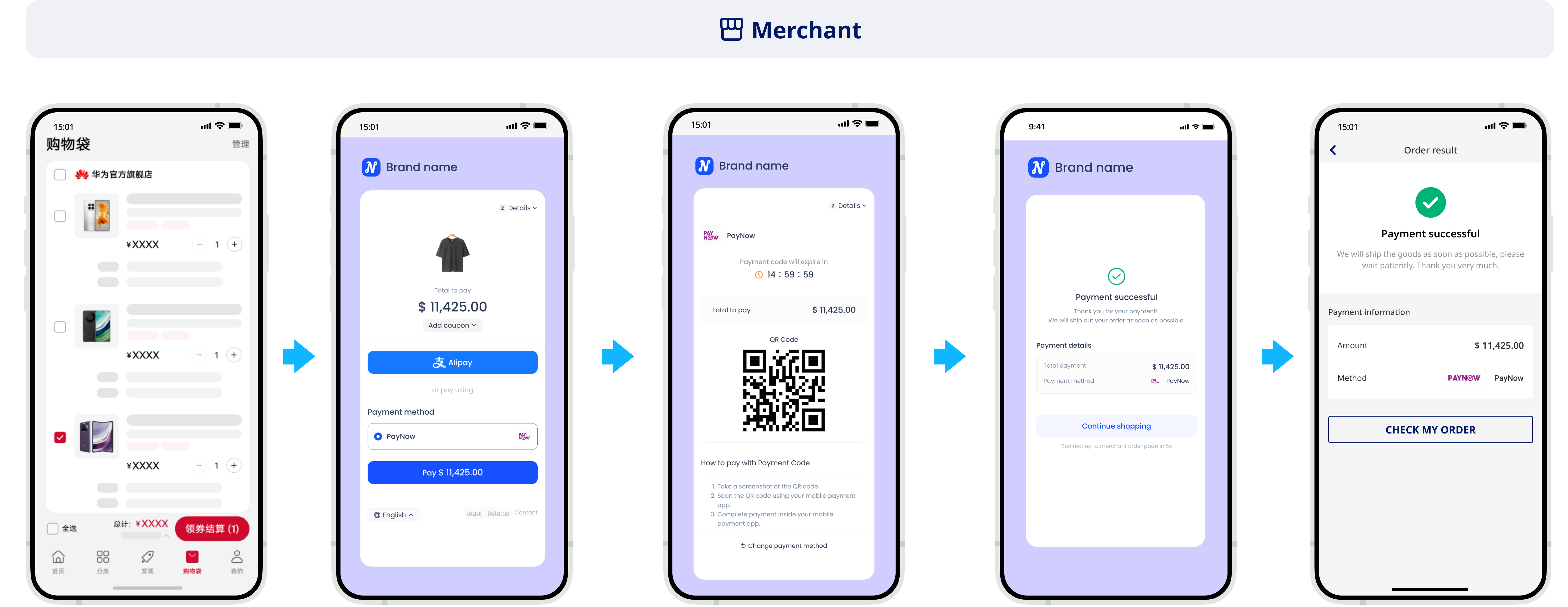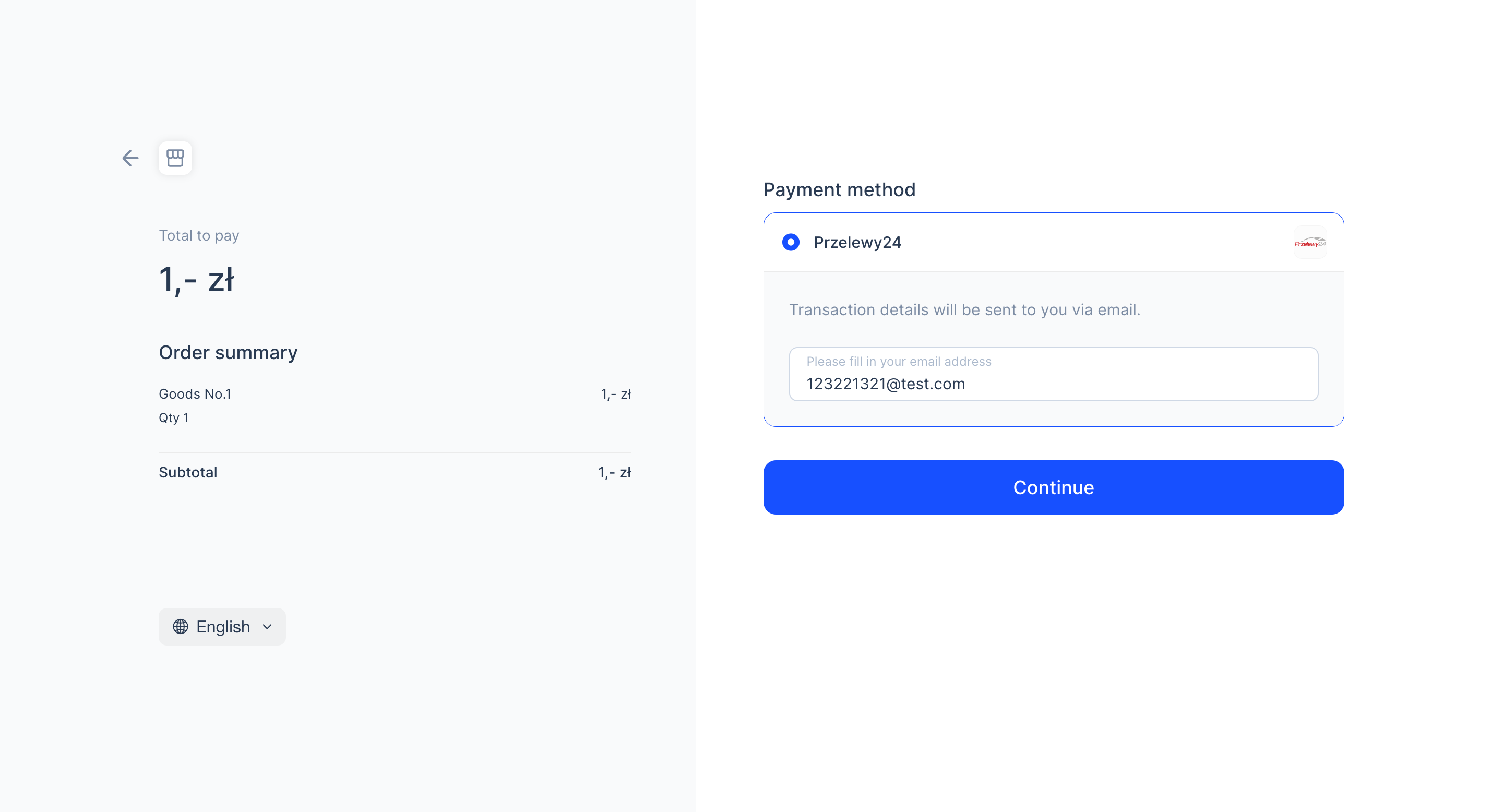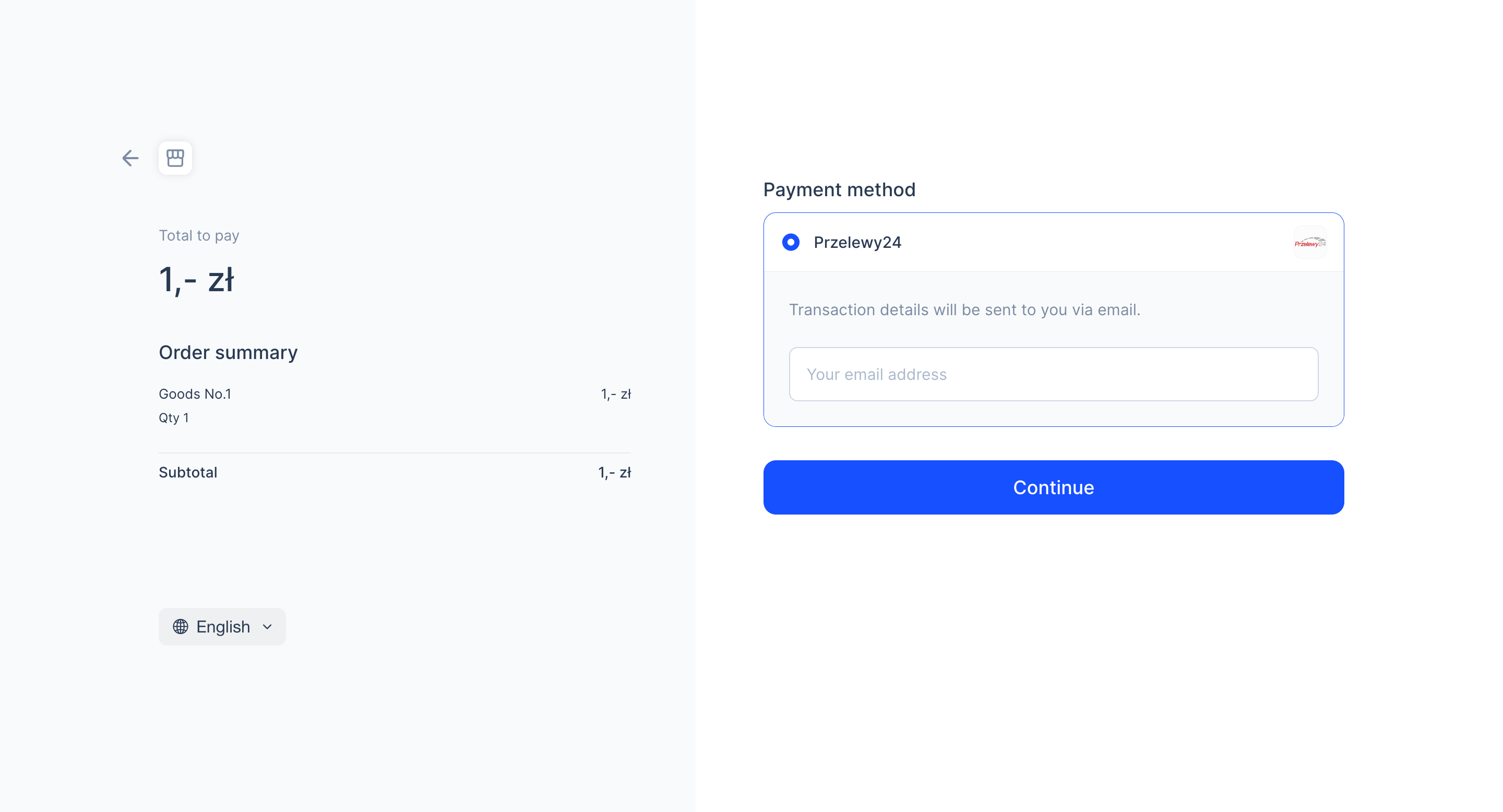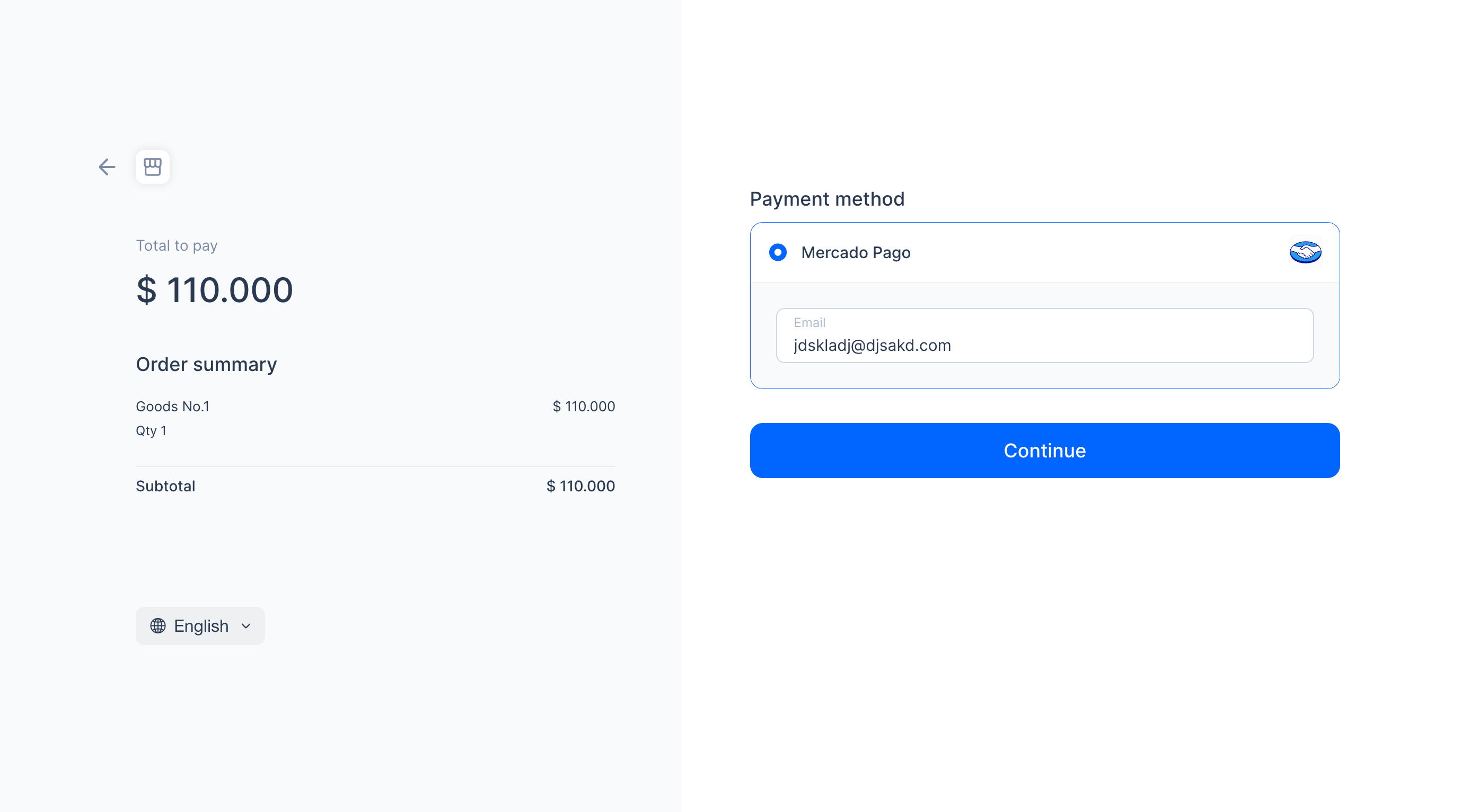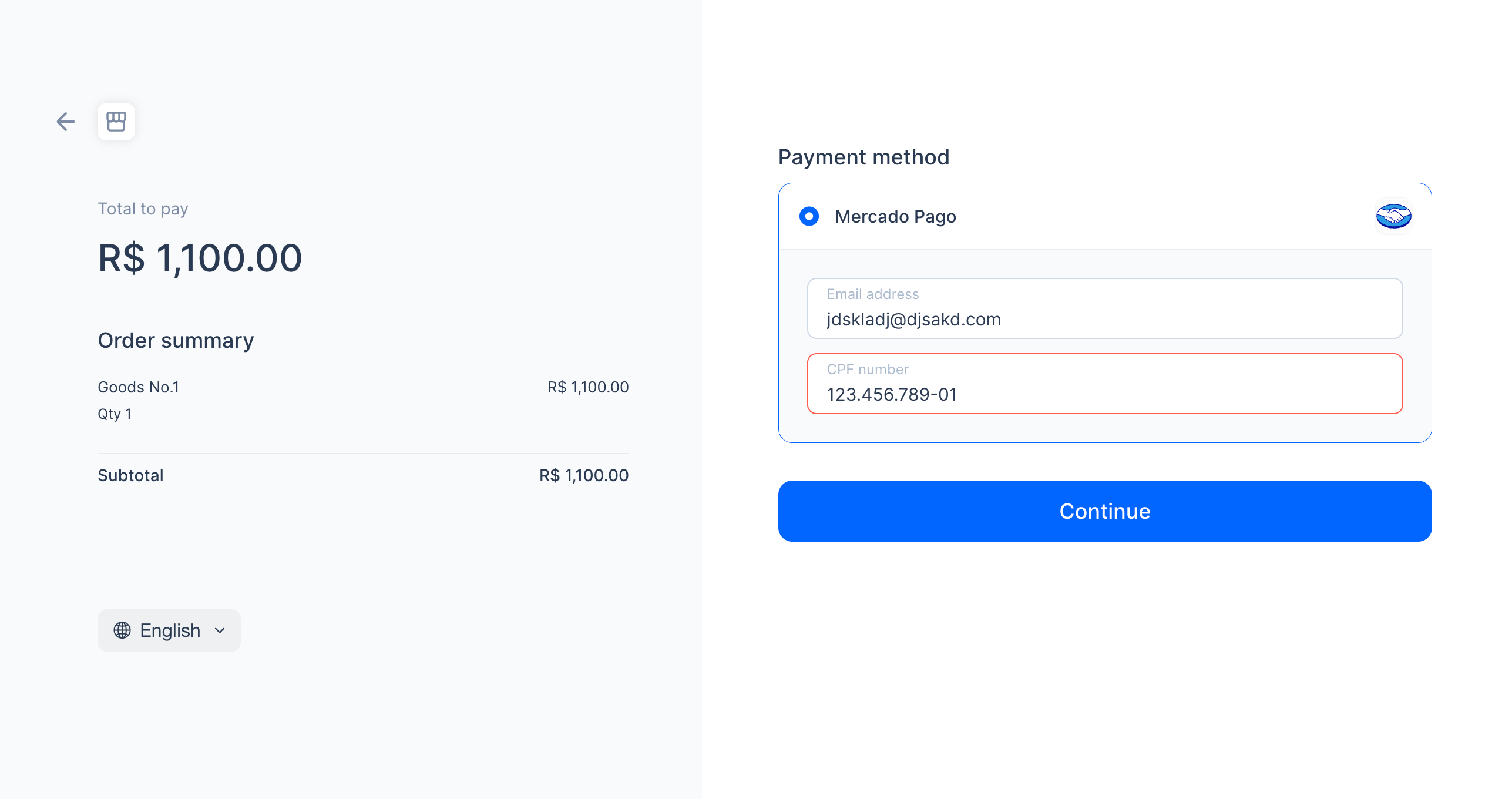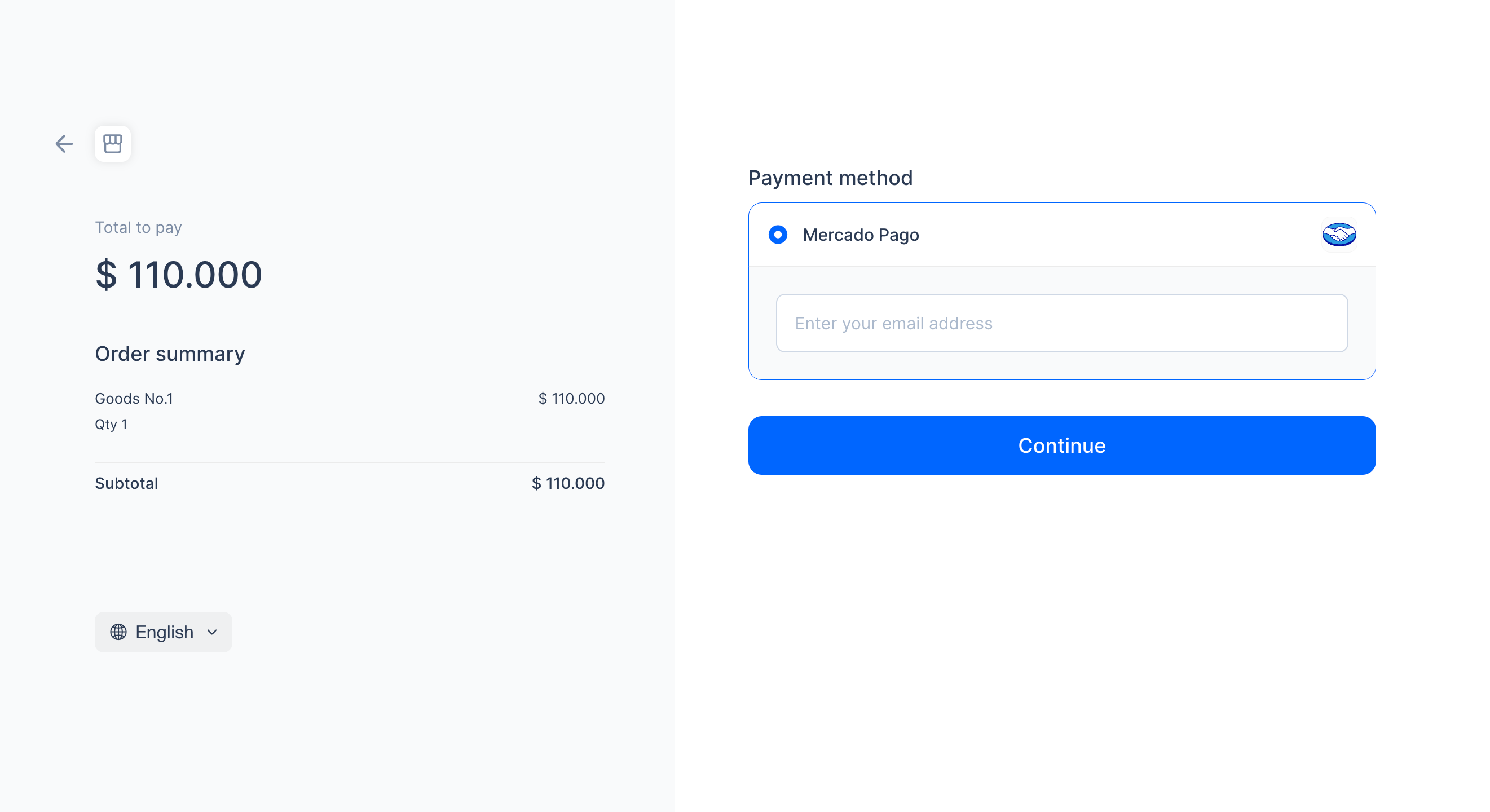Embedded mode
Antom Checkout Page (CKP) is a user-friendly, low-code payment solution that simplifies global transactions. Supporting a wide range of payment methods, CKP meets the needs of different markets and business scenarios. With minimal setup, you can quickly create a professional, feature-rich checkout page that offers buyers a smooth and convenient payment experience while significantly improving payment integration efficiency and driving business growth.
This guide shows you how to integrate CKP through an SDK, where the Antom Checkout Page is embedded into your product purchase page for buyers to make payment.
User experience
The image shows the user experience where the Antom Checkout Page is embedded into the merchant page:
The image shows the user experience for scenarios where certain payment methods redirect to the corresponding payment page within the embedded Checkout Page:
Note: Currently, embedded CKP is only supported on PC and mobile (H5), but not supported on mobile apps.
Payment flow
The following process shows how to integrate the embedded CKP:
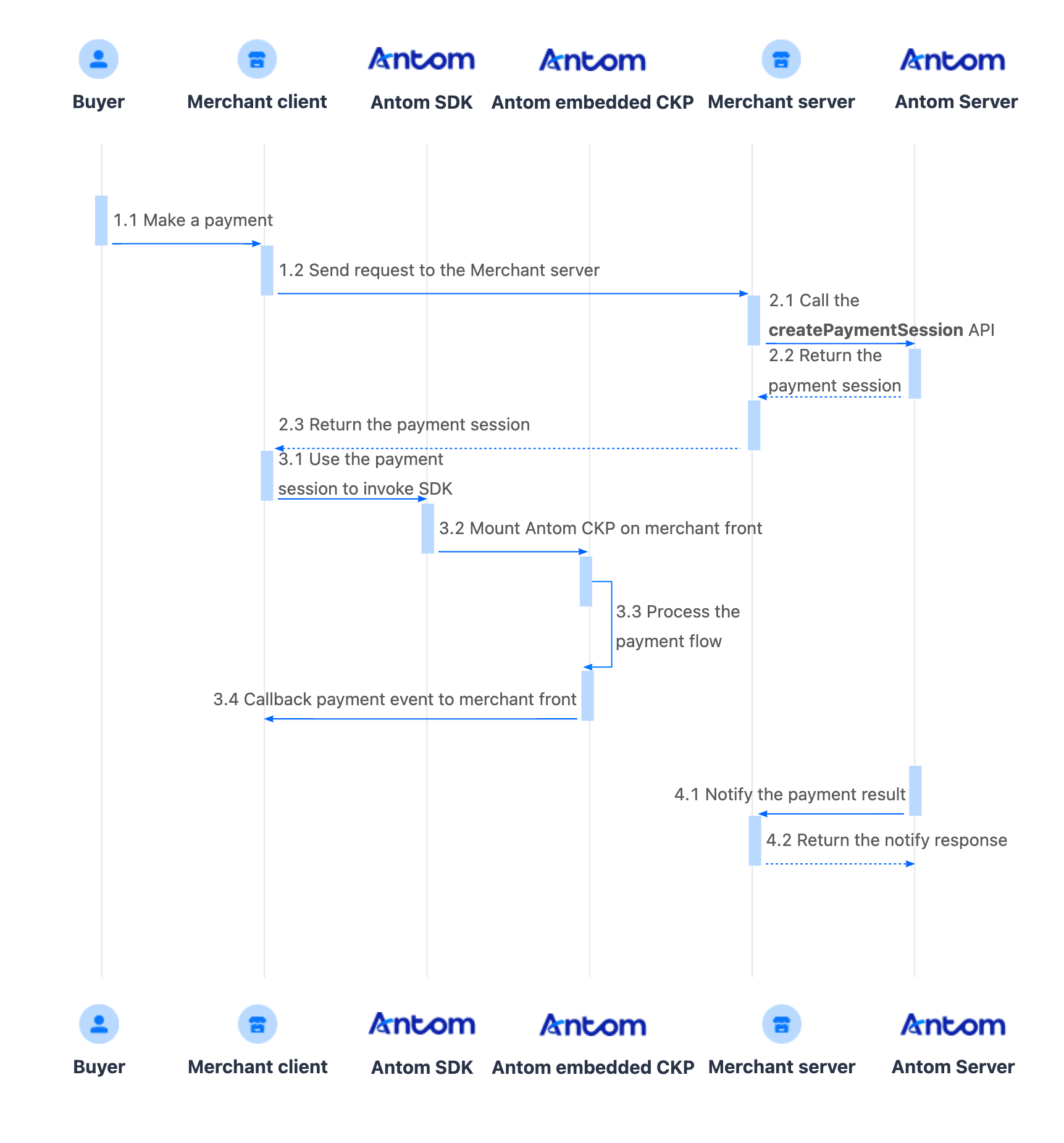
- The buyer places an order in the merchant side.
- Create a payment session request.
When a buyer places an order on the merchant side, you need to call the createPaymentSession (Checkout Payment) API to obtain the paymentSessionData that calls the SDK.
- Invoke the client SDK.
The merchant uses the paymentSessionData to call the SDK embedded Checkout Page component in the merchant web page, and then the buyer submits the payment in the Checkout Page component, and the SDK will process the payment process.
- Get the payment result.
You can retrieve payment results through asynchronous notifications. Configure the paymentNotifyUrl parameter in the createPaymentSession (Checkout Payment) API to specify the URL to receive asynchronous notifications. Antom sends an asynchronous notification through the notifyPayment API when a payment request succeeds or expires.
Integration preparations
Before you start integrating, read the Integration Guide and API Overview documents to understand the integration steps of the server-side API and the precautions for calling the API. Furthermore, ensure that the following prerequisites are met:
- Obtain a client ID
- Complete the key configuration
- Complete the configuration of paymentNotifyUrl to receive the asynchronous notification
- Integrate the server-side SDK package, install the server-side library, and initialize a request instance. For more details, refer to Server-side SDKs.
- Refer to Integrate the SDK package for Web/WAP to complete integration preparations, and ensure to use SDK 1.41.0 or above.
Integration steps
Follow these steps to start the integration:
- Create a payment session
- Embed the Antom Checkout Page
- Process asynchronous notifications
Step 1: Create a payment session
Buyers can select a payment method provided by Antom when making payments. For payment method configurations, see Specify a payment method. When the buyer makes a payment, you need to collect key information, such as the payment request ID, order details, payment redirect URL, and payment notification URL. Call the createPaymentSession (Checkout Payment) API to create a payment session and redirect to the Antom Checkout Page.
1. Call the createPaymentSession API
The following sample code shows how to call the createPaymentSession (Checkout Payment) API:
public static void createPaymentSession() {
AlipayPaymentSessionRequest alipayPaymentSessionRequest = new AlipayPaymentSessionRequest();
alipayPaymentSessionRequest.setProductCode(ProductCodeType.CASHIER_PAYMENT);
alipayPaymentSessionRequest.setProductScene(ProductSceneConstants.CHECKOUT_PAYMENT);
// set amount
Amount amount = Amount.builder().currency("SGD").value("6000").build();
alipayPaymentSessionRequest.setPaymentAmount(amount);
// replace with your paymentRequestId
String paymentRequestId = UUID.randomUUID().toString();
alipayPaymentSessionRequest.setPaymentRequestId(paymentRequestId);
// replace with your orderId
String orderId = UUID.randomUUID().toString();
// set buyer info
Buyer buyer = Buyer.builder().referenceBuyerId("yourBuyerId").build();
// set goods info
Goods goods = Goods.builder().goodsBrand("Antom Brand").goodsCategory("outdoor goods/bag").goodsName("Classic Woman Bag").goodsQuantity("1")
.goodsSkuName("Black").goodsImageUrl("https://mdn.alipayobjects.com/portal_pdqp4x/afts/file/A*H8M9RrxlArAAAAAAAAAAAAAAAQAAAQ")
.goodsUnitAmount(amount).goodsUrl("https://yourGoodsUrl").referenceGoodsId("yourGoodsId").build();
// set order info
Order order = Order.builder().referenceOrderId(orderId)
.orderDescription("antom ckp testing order").orderAmount(amount).buyer(buyer).goods(Stream.of(goods).collect(Collectors.toList())).build();
alipayPaymentSessionRequest.setOrder(order);
// replace with your notify url
// or configure your notify url here: <a href="https://dashboard.antom.com/global-payments/developers/iNotify">Notification URL</a>
alipayPaymentSessionRequest.setPaymentNotifyUrl("http://www.yourNotifyUrl.com/payment/receiveNotify");
// replace with your redirect url
alipayPaymentSessionRequest.setPaymentRedirectUrl(
"http://localhost:8080/index.html?paymentRequestId=" + paymentRequestId);
AlipayPaymentSessionResponse alipayPaymentSessionResponse;
try {
alipayPaymentSessionResponse = CLIENT.execute(alipayPaymentSessionRequest);
} catch (AlipayApiException e) {
String errorMsg = e.getMessage();
// handle error condition
}
}2. Create a payment session
If your payment methods include card payments, buyer information from the merchant side must be provided in the payment session parameters. For details, please refer to Card payments.
Creating a payment session includes the following parameters:
Field type | Field name | Required | Description |
Base fields | productCode | Yes | The value of this field in this scenario is fixed as CASHIER_PAYMENT. |
productScene | Yes | The value of this field in this scenario is fixed as CHECKOUT_PAYMENT. | |
paymentRequestId | Yes | The unique ID assigned by a merchant to identify a payment request. | |
| paymentAmount | Yes | The payment amount that the merchant requests to receive in the order currency. | |
paymentRedirectUrl | Yes | The merchant page URL that the buyer is redirected to after the payment is completed. | |
| paymentNotifyUrl | No | The URL that is used to receive the payment result notification. You can also set the URL to receive the result notification on Antom Dashboard. | |
| settlementStrategy | No | The settlement strategy for the payment request. Specify the settlementCurrency parameter in the API if you signed up for multiple settlement currencies. | |
locale | No | Language tag specified for the Checkout Page. If this field is empty or set to automatic, the default language setting of the browser will be used, which is usually English. | |
paymentFactor.isAuthorization | No | Indicates whether the payment scenario requires authorization. Valid values are:
| |
Order fields | order.orderAmount | Yes | Order amount. |
order.referenceOrderId | Yes | Order ID. | |
order.orderDescription | Yes | Order description. |
The above parameters are the basic parameters for creating a payment session. For complete and additional requirements for specific payment methods, please refer to createPaymentSession (Checkout Payment).
The following shows the sample code of a request:
{
"order": {
"buyer": {
"referenceBuyerId": "yourBuyerId"
},
"goods": [
{
"goodsBrand": "Antom Brand",
"goodsCategory": "outdoor goods/bag",
"goodsImageUrl": "https://mdn.alipayobjects.com/portal_pdqp4x/afts/file/A*H8M9RrxlArAAAAAAAAAAAAAAAQAAAQ",
"goodsName": "Classic Woman Bag",
"goodsQuantity": "1",
"goodsSkuName": "Black",
"goodsUnitAmount": {
"currency": "SGD",
"value": "6000"
},
"goodsUrl": "https://yourGoodsUrl",
"referenceGoodsId": "yourGoodsId"
}
],
"orderAmount": {
"currency": "SGD",
"value": "6000"
},
"orderDescription": "antom ckp testing order",
"referenceOrderId": "c3df9b82-ff67-424b-880b-06c3615b46ea"
},
"paymentAmount": {
"currency": "SGD",
"value": "6000"
},
"paymentNotifyUrl": "http://www.yourNotifyUrl.com/payment/receiveNotify",
"paymentRedirectUrl": "http://localhost:8080/index.html?paymentRequestId=597795b7-c812-4132-bd7d-c55914eefdcb",
"paymentRequestId": "597795b7-c812-4132-bd7d-c55914eefdcb",
"productCode": "CASHIER_PAYMENT",
"productScene": "CHECKOUT_PAYMENT"
}The following shows the sample code of a response, which contains the following parameters:
- paymentSessionData: The encrypted payment session data. Pass the data to your front end.
- paymentSessionExpiryTime: The specific date and time after which the payment session will expire.
- normalUrl: The URL used to redirect to the Checkout Page (In Antom embedded CKP scenario, this field can be ignored.).
{
"normalUrl": "https://checkout.antom.com/checkout-page/pages/payment/index.html?sessionData=1iwX2rH5kXnUGT5372d0kHD7PwcgPmRSMgAsvKs8hqRkqobbtWbep59PU2eO5w72h%2B%2XXXX",
"paymentSessionData": "1iwX2rH5kXnUGT5372d0kHD7PwcgPmRSMgAsvKs8hqRkqobbtWbep59PU2eO5w72h+/c278B+P+nDVNzrQySQQ==&&SG&&188&&eyJleHRlbmRJbmZvIjoie1wiT1BFTl9NVUxUSXXXX",
"paymentSessionExpiryTime": "2025-03-19T16:21:06+08:00",
"paymentSessionId": "1iwX2rH5kXnUGT5372d0kHD7PwcgPmRSMgAsvKs8hqSln4WiVZXXXX",
"result": {
"resultCode": "SUCCESS",
"resultMessage": "success.",
"resultStatus": "S"
}
}The table shows the possible values that the result.resultStatus field in the request message may return. Please handle the result according to the guidances:
| result.resultStatus | Message | Further actions |
S | Indicates that payment session creation succeeded. | The merchant server can use paymentSessionData to call the SDK. |
U | Indicates that payment session creation failed for unknown reasons. |
Please change the paymentRequestId and call the API again to resolve the issue. Please contact Antom technical support if the problem persists. |
F | Indicates that the payment session creation failed. | Please check and verify whether the current API required request fields (including header fields and body fields) are correctly passed and valid.
|
Note: If you did not receive a response message, it might be due to a network timeout. Please change the paymentRequestId and call the API again to resolve the issue.
Step 2: Embed Antom Checkout Page
The Antom SDK is a component used for handling payment processes. You initiate the SDK by creating a payment session to collect information and switch between apps based on the payment method specified in the createPaymentSession (Checkout Payment) API.
1. Instantiate the SDK
Use AMSCheckoutPage to create an SDK instance. The configuration object includes the following parameters:
Parameter name | Required | Description |
environment | Yes | It is used to pass in environmental information. Valid values are:
|
onEventCallback | No | A callback function returns a specific event code when a payment event happens during SDK runtime, like payment result or a form submission error. For further information, refer to SDK References. |
The following sample code shows how to instantiate the SDK:
npm:
import { AMSCheckoutPage } from '@alipay/ams-checkout' // Package manager
const checkoutApp = new AMSCheckoutPage({
environment: "sandbox",
onEventCallback: ({code, message}) => {},
});
cdn:
// Under CDN method: Use window.AMSCheckoutPage to instantiate
const checkoutApp = new AMSCheckoutPage({
environment: "sandbox",
onEventCallback: ({code, message}) => {},
});2. Invoke the SDK
When the buyer places an order and redirects to the Antom Checkout Page, you need to create the SDK and instantiate it with a payment session.
Create a DOM node
On your checkout page, create a DOM node to embed the Antom Checkout Page component.
<div class="content">
<div class="checkout-container" id="ckp-embed-wrapper"></div>
</div>Create the component
Use the mountComponent function in the instance object to create the Antom Checkout Page component:
Parameter name | Required | Description |
sessionData | Yes | Create a configuration object using the sessionData parameter. Pass the complete paymentSessionData parameter obtained in the createPaymentSession (Checkout Payment) API response to the sessionData parameter. |
async function create(sessionData) {
await checkoutApp.mountComponent({
sessionData: sessionData,
},'#ckp-embed-wrapper');
}Destroy the component
Call the unmount method to free SDK component resources in the following situations:
- When the buyer switches views away from the checkout page, free the component resources created in createPaymentSession (Checkout Payment).
- When the buyer initiates multiple payments, free the previously created component resources in createPaymentSession (Checkout Payment).
- Free the component resources after obtaining the final payment result codes.
// Free SDK component resources
checkoutApp.unmount();3. Process payment results
The payment result will be returned by onEventCallback function. You need to customize the processing flow you want for each payment result through the data in the result of onEventCallback. The payment result here is only for front-end display, and the final order status is subject to the server side.
The following are the possible event codes of the payment result returned by onEventCallback:
Event code | Message | Further actions |
| Payment is successful. | It is recommended to redirect the buyer to the payment result page. |
| Payment failed. | It is recommended that you check the value of paymentResultCode in the |
| Event that is triggered when the buyer clicks the Back to merchant control on the results page. | It is recommended to redirect the buyer to the payment result page. |
| The buyer exits the payment page without submitting the order. | The SDK can be reinvoked with paymentSessionData within the validity period; if it has expired, paymentSessionData needs to be requested again. |
The following sample code shows how to process onEventCallback:
function onEventCallback({ code, result }) {
switch (code) {
case 'SDK_PAYMENT_SUCCESSFUL':
// Payment was successful. Redirect buyers to the payment result page.
break;
case 'SDK_PAYMENT_FAIL':
console.log('Check the payment result data', result);
// Payment failed. Guide buyers to retry the payment based on the provided information.
break;
case 'SDK_PAYMENT_CANCEL':
// Guide buyers to retry the payment.
break;
case 'SDK_PAYMENT_CLICK_BACK_TO_MERCHANT':
// User click the Back to merchant button. Redirect buyers to the payment result page.
break;
default:
break;
}
}The image shows the rendered merchant's page embedded with the Antom Checkout Page:
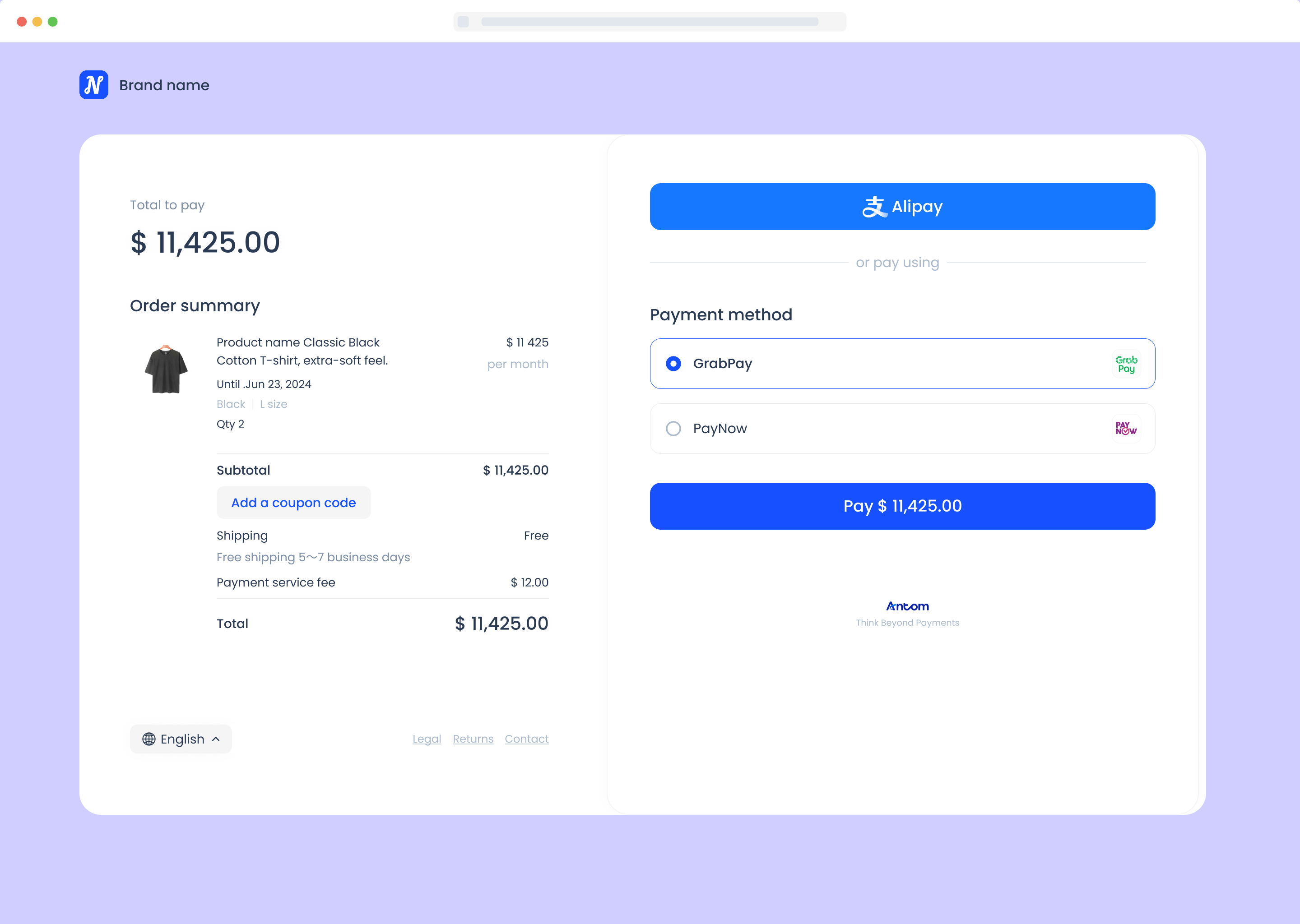
Step 3: Process asynchronous notifications
1. Set the webhook URL to receive notifications
You can choose one of following two methods to set the webhook URL to receive notifications:
- If each of your orders has a unique notification URL, we recommend to set the webhook URL in each individual request. You can pass the asynchronous notification receiving URL for the specific order through the paymentNotifyUrl field in the createPaymentSession (Checkout Payment) API.
- If all your orders share a unified notification URL, you can set the webhook URL on Antom Dashboard through Developer > Notification Address. For detailed steps, refer to Notification URL.
When a payment succeeds or fails, Antom sends an asynchronous notification (notifyPayment) to the address that you specified in the createPaymentSession (Checkout Payment) API via the paymentNotifyUrl parameter. After receiving the notifications from Antom, you need to return response according to Return a receipt acknowledgement message.
Antom allows you to specify the URL in the createPaymentSession (Checkout Payment) API via the paymentNotifyUrl parameter. If the address of each payment is the same, you can also configure the address on Antom Dashboard.
The following is the notification request sample code:
- paymentRequestId: indicats the payment request ID for consult, cancellation, and reconciliation.
- paymentId: indicates the payment ID aligned by Antom for refunds and reconciliation.
- paymentAmount: indicates the payment amount.
- paymentMethodType: indicates the payment method used by the buyer.
{
"actualPaymentAmount": {
"currency": "KRW",
"value": "100"
},
"notifyType": "PAYMENT_RESULT",
"paymentAmount": {
"currency": "KRW",
"value": "100"
},
"paymentCreateTime": "2024-04-19T01:10:49-07:00",
"paymentId": "20240419194010800100188350218317930",
"paymentRequestId": "amsdmpay_yuqian_fyf_0b3bd5e9-14bd-4cea-b288-091d9c6862ed",
"paymentResultInfo": {},
"paymentTime": "2024-04-19T01:12:14-07:00",
"pspCustomerInfo": {
"pspCustomerId": "a070c0d1b89af442c6aa01886f0183de812a5d3d4fe15c771145b2b844a9dd67",
"pspName": "TOSSPAY"
},
"paymentMethodType": "TOSSPAY",
"result": {
"resultCode": "SUCCESS",
"resultMessage": "success.",
"resultStatus": "S"
}
}The table shows the possible values that the result.resultStatus field in the request message may return. Please handle the result according to the guidances:
result.resultStatus | Message | Further actions |
| Indicates that the payment is successful. | You can advance the order status. |
| Indicates that the payment failed. | Please guide the buyer to place a new order. |
Common Questions
Q: When will the notification be sent?
A: The sending time of asynchronous notifications varies in different scenarios.
- If the payment is successfully completed, Antom will usually send you an asynchronous notification within 3 to 5 seconds. For some payment methods like cash payment, the notification might take a bit longer.
- If the buyer does not submit a payment, when the payment session times out, Antom does not send an asynchronous notification.
- If the buyer submits a payment but the final payment is not completed:
- When the last order is closed, if the payment session is still valid, Antom will send asynchronous notifications when the payment session expires.
- When the last order is closed, if the payment session expired, Antom will send an asynchronous notification when the last order is closed.
Note: The default payment session expiry time is 1 hour. The time it takes to close an order varies for different payment methods, the default is 14 minutes.
Q: Will the asynchronous notification be re-sent?
A: Yes, the asynchronous notification will be re-sent automatically within 24 hours for the following cases:
- If you didn't receive the asynchronous notification due to network reasons.
- If you receive an asynchronous notification from Antom, but you didn't make a response to the notification in the Sample code format.
The notification can be resent up to 8 times or until a correct response is received to terminate delivery. The sending intervals are as follows: 0 minutes, 2 minutes, 10 minutes, 10 minutes, 1 hour, 2 hours, 6 hours, and 15 hours.
Q: What are the key parameters in the notification that I need to use?
A: Pay attention to the following key parameters:
- result: indicates the payment result of the order.
- paymentRequestId: indicates the payment request number you generated for consult, cancel, and reconciliation.
- paymentId: indicates the payment order number generated by Antom, used for refund and reconciliation.
- paymentAmount: indicates the payment amount.
- paymentMethodTpye: indicates the payment method type that is included in payment method options.
Q: There are two types of asynchronous notifications. Which one should be used as the basis for shipment?
A: When you receives a
PAYMENT_RESULTnotifyType notification, you should first check whether the paymentMethodType isCARD. If it is notCARD, you can decide whether to proceed with shipment based on the result of this notification. If it isCARD, you need to wait for a notification ofCAPTURE_RESULTtype before making the decision to ship.
2. Verify asynchronous notifications
If you receive an asynchronous notification from Antom, you are required to return the response in the Sample code format, but you do not need to countersign the response.
You need to verify the signature of the payment notification sent by Antom.
/**
* receive notify
*
* @param request request
* @param notifyBody notify body
* @return Result
*/
@PostMapping("/receiveNotify")
@ResponseBody
public Result receiveNotify(HttpServletRequest request, @RequestBody String notifyBody) {
// retrieve the required parameters from http request
String requestUri = request.getRequestURI();
String requestMethod = request.getMethod();
// retrieve the required parameters from request header
String requestTime = request.getHeader("request-time");
String clientId = request.getHeader("client-id");
String signature = request.getHeader("signature");
try {
// verify the signature of notification
boolean verifyResult = WebhookTool.checkSignature(requestUri, requestMethod, clientId,
requestTime, signature, notifyBody, ANTOM_PUBLIC_KEY);
if (!verifyResult) {
throw new RuntimeException("Invalid notify signature");
}
// deserialize the notification body
JSONObject jsonObject = JSON.parseObject(notifyBody);
String notifyType = (String)jsonObject.get("notifyType");
if("PAYMENT_RESULT".equals(notifyType)){
AlipayPayResultNotify paymentNotify = jsonObject.toJavaObject(AlipayPayResultNotify.class);
if (paymentNotify != null && "SUCCESS".equals(paymentNotify.getResult().getResultCode())) {
// handle your own business logic.
// e.g. The relationship between payment information and users is kept in the database.
System.out.println("receive payment notify: " + JSON.toJSONString(paymentNotify));
return Result.builder().resultCode("SUCCESS").resultMessage("success.").resultStatus(ResultStatusType.S).build();
}
}else if("CAPTURE_RESULT".equals(notifyType)){
AlipayCaptureResultNotify captureNotify = jsonObject.toJavaObject(AlipayCaptureResultNotify.class);
if (captureNotify != null && "SUCCESS".equals(captureNotify.getResult().getResultCode())) {
// handle your own business logic.
System.out.println("receive capture notify: " + JSON.toJSONString(captureNotify));
return Result.builder().resultCode("SUCCESS").resultMessage("success.").resultStatus(ResultStatusType.S).build();
}
}
} catch (Exception e) {
return Result.builder().resultCode("FAIL").resultMessage("fail.").resultStatus(ResultStatusType.F).build();
}
return Result.builder().resultCode("SYSTEM_ERROR").resultMessage("system error.").resultStatus(ResultStatusType.F).build();
}You do not need to sign the response for the notification result. However, you must respond to each notification request in the following fixed format, regardless of whether the payment is successful or not.
{
"result": {
"resultCode": "SUCCESS",
"resultStatus": "S",
"resultMessage": "success"
}
}After payments
Inquire payments
In addition to obtaining the buyer's payment result through the asynchronous notification, you can retrieve the corresponding payment result through the inquire payments service. You can call the inquiryPayment API and use the paymentRequestId from the payment session to check the payment status.
The following code shows how to call the inquiryPayment API:
public static void inquiryPayment() {
AlipayPayQueryRequest alipayPayQueryRequest = new AlipayPayQueryRequest();
// replace with your paymentRequestId
alipayPayQueryRequest.setPaymentRequestId("yourPaymentRequestId");
AlipayPayQueryResponse alipayPayQueryResponse = null;
try {
alipayPayQueryResponse = CLIENT.execute(alipayPayQueryRequest);
} catch (AlipayApiException e) {
String errorMsg = e.getMessage();
// handle error condition
}
}The following code shows an example of a response:
{
"actualPaymentAmount": {
"currency": "USD",
"value": "1"
},
"customsDeclarationAmount": {
"currency": "CNY",
"value": "7"
},
"paymentAmount": {
"currency": "USD",
"value": "1"
},
"paymentId": "20250305194010800100188690281017336",
"paymentMethodType": "ALIPAY_CN",
"paymentRedirectUrl": "https://checkout.antom.com/checkout-page/pages/payment/index.html?sessionData=%2BCUim8L0KviXagaygm9xBL5jZ%2F75w6gAX1nn8pcuFuGkIsMoHtD6U88YSyMrMJvorbwnBg5uQv8e6pyvIpjDQQ%3D%3D%26%26SG%26%26188%26%26eyJleHRlbmRJbmZvIjoie1wiT1BFTl9NVUxUSV9QQVlNRU5UX0FCSUxJVFlcIjpcInRydWVcIixcImxvY2FsZVwiOlwiZW5fVVNcIixcImRpc3BsYXlBbnRvbUxvZ29cIjpcInRydWVcIn0iLCJwYXltZW50U2Vzc2lvbkNvbmZpZyI6eyJwYXltZW50TWV0aG9kQ2F0ZWdvcnlUeXBlIjoiQUxMIiwicHJvZHVjdFNjZW5lIjoiQ0hFQ0tPVVRfUEFZTUVOVCIsInByb2R1Y3RTY2VuZVZlcnNpb24iOiIxLjAifSwic2VjdXJpdHlDb25maWciOnsiYXBwSWQiOiIiLCJhcHBOYW1lIjoiT25lQWNjb3VudCIsImJpelRva2VuIjoiNlRjZGJyMnJGM3JQWXg0aGtWckhxYnZqIiwiZ2F0ZXdheSI6Imh0dHBzOi8vaW1ncy1zZWEuYWxpcGF5LmNvbS9tZ3cuaHRtIiwiaDVnYXRld2F5IjoiaHR0cHM6Ly9vcGVuLXNlYS1nbG9iYWwuYWxpcGF5LmNvbS9hcGkvb3Blbi9yaXNrX2NsaWVudCIsIndvcmtTcGFjZUlkIjoiIn0sInNraXBSZW5kZXJQYXltZW50TWV0aG9kIjpmYWxzZX0%3D",
"paymentRequestId": "PAYMENT_20250305220039086_AUTO",
"paymentResultCode": "SUCCESS",
"paymentResultMessage": "success.",
"paymentStatus": "SUCCESS",
"paymentTime": "2025-03-05T06:02:34-08:00",
"pspCustomerInfo": {
"pspName": "ALIPAY_CN"
},
"result": {
"resultCode": "SUCCESS",
"resultMessage": "success.",
"resultStatus": "S"
}
}The table shows the possible values of paymentStatus returned in the response:
paymentStatus | Message |
SUCCESS | Indicates that the payment is successful. |
FAIL | Indicates that the payment failed. |
Note: When inquiring about the transaction, if the buyer does not submit the order, the
ORDER_NOT_EXISTerror code will be returned. This error is not returned if the order is submitted.
Refund
To learn about Antom refund rules and how to initiate a refund for a successful transaction, see Refund for more information.
Dispute
When a buyer chooses to pay with a card, a dispute may occur. To learn more, see Dispute.
Reconciliation
After the transaction is completed, use the financial reports provided by Antom for reconciliation. For more information on how to reconcile and the settlement rules of Antom, please refer to Reconciliation.
Payment method features
Card payments
If your payment method includes cards, the buyer's information from the merchant side must be passed in the payment session parameters. In the order.buyer field, at least one of the following parameters must be provided: referenceBuyerId, buyerPhoneNo, or buyerEmail. If the buyer's information is not provided, when the buyer selects the card payment method and submits the payment, an error will occur on the page, resulting in the inability to complete the payment process.
{
"order": {
...
"buyer": {
"referenceBuyerId": "88888888",
"buyerEmail": "gaga@test.com",
"buyerPhoneNo": "18888888888"
}
},
...
}Activate 3D Secure 2
To learn more about 3D Secure 2, see 3D Secure 2 authentication.
- If you already possess risk control capabilities or have integrated third-party risk control services: you can specify the value of availablePaymentMethod.paymentMethodMetaData.is3DSAuthentication as
TRUEthrough the createPaymentSession (Checkout Payment) API based on your risk assessment. - If you currently do not have risk control capabilities: you can contact the Antom business team to enable Antom card fraud risk service. With this service, the Antom risk control model will assist in determining whether a transaction requires 3DS authentication for security verification. In this scenario, you do not need to set the value of availablePaymentMethod.paymentMethodMetaData.is3DSAuthentication.
{
...
"availablePaymentMethod": {
"paymentMethodMetaData": {
"is3DSAuthentication": true
}
},
...
}When a transaction passes 3DS authentication, the corresponding 3DS information will be included in the asynchronous notification. You can check the information in the paymentResultInfo.threeDSResult field.
{
"actualPaymentAmount": {
"currency": "HKD",
"value": "10"
},
"notifyType": "PAYMENT_RESULT",
"paymentAmount": {
"currency": "HKD",
"value": "10"
},
"paymentCreateTime": "2025-03-01T02:58:03-08:00",
"paymentId": "20250301194010800100188350280757901",
"paymentMethodType": "CARD",
"paymentRequestId": "PAYMENT_20250301185416669_AUTO",
"paymentResultInfo": {
"avsResultRaw": "I",
"cardBrand": "VISA",
"cardCategory": "CONSUMER",
"cardNo": "************0197",
"cardToken": "ALIPAYEfG2DFbGx2Eh739qU+VMnCPEe7MfRKfMfC5k7k/IFASWpAh/vCxHV3dPYpbkGz1iyWCloE4MwfmN48sP8+rSPQ==",
"cvvResultRaw": "",
"funding": "CREDIT",
"issuingCountry": "HK",
"networkTransactionId": "585060394953881",
"paymentMethodRegion": "GLOBAL",
"threeDSResult": {
"cavv": "AJkBAyh5UQAAAAAKNEBgdQAAAAA=",
"eci": "05",
"threeDSVersion": "2.2.0"
}
},
"paymentTime": "2025-03-01T02:58:19-08:00",
"result": {
"resultCode": "SUCCESS",
"resultMessage": "success.",
"resultStatus": "S"
}
}APM payments
Przelewy24
When the buyer selects Przelewy24 as the payment method, you can optimize the email input experience:
Pass the availablePaymentMethod.paymentMethodMetaData.payerEmail field in the createPaymentSession (Checkout Payment) API. The Antom Checkout Page will automatically pre-fill the email address in the payment options, eliminating the need for manual input by the buyer.
The sample code:
{
...
"availablePaymentMethod": {
"paymentMethodMetaData": {
"payerEmail": "123221321@test.com",
}
},
...
}When the buyer selects Przelewy24 to pay, Antom Chechout page will pre-fill the email address:
Mercado Pago
When the buyer selects Mercado Pago as the payment method, you can optimize the input experience using the following methods:
- Pass the availablePaymentMethod.paymentMethodMetaData.payerEmail field in the createPaymentSession (Checkout Payment) API. The Antom Checkout Page will automatically pre-fill the email address in the payment options, eliminating the need for manual input by the buyer.
- Pass the availablePaymentMethod.paymentMethodMetaData.cpf field in the createPaymentSession (Checkout Payment) API. The Antom Checkout Page will automatically pre-fill the CPF number, eliminating the need for manual input by the buyer.
The sample code:
{
...
"availablePaymentMethod": {
"paymentMethodMetaData": {
"payerEmail": "123221321@test.com",
}
},
...
}When the buyer selects Mercado Pago to pay, Antom Chechout page will pre-fill the email address:
Additional content
Antom Tokenization
With Antom Tokenization, you can allow buyers to save their card information during the first payment, saving them from needing to re-enter the information in subsequent transactions. This helps avoid payment failures caused by incorrect card details. For details, please refer to Antom Tokenization.
Specify a payment method
You can specify payment methods on Antom Dashboard through Payments > Checkout page > Payment methods. You can also pass the parameters in the createPaymentSession (Checkout Payment) API to specify the display of payment methods on Checkout Page, the order of the payment method list, and the display of quick payments.
Note: If you pass parameters through the API, the API values take priority.
This feature offers you the following benefits:
- Filter local payment methods based on your business region.
- Sort your preferred payment methods.
- Display the mainstream quick payments, such as Alipay, Apple Pay, and Google Pay.
To specify the payment method, pass the following parameters in the availablePaymentMethod parameter of the createPaymentSession (Checkout Payment) API:
Parameter name | Required | Description |
paymentMethodTypeList | No | List of payment methods available to the buyer. The list includes the following parameters:
|
The following is a sample code for specifying the payment method:
{ ...
"availablePaymentMethod": {
"paymentMethodTypeList": [
{
"paymentMethodType": "ALIPAY_CN",
"expressCheckout": true,
"paymentMethodOrder": "0"
},
{
"paymentMethodType": "TNG",
"expressCheckout": false,
"paymentMethodOrder": "1"
}
]
}
}


